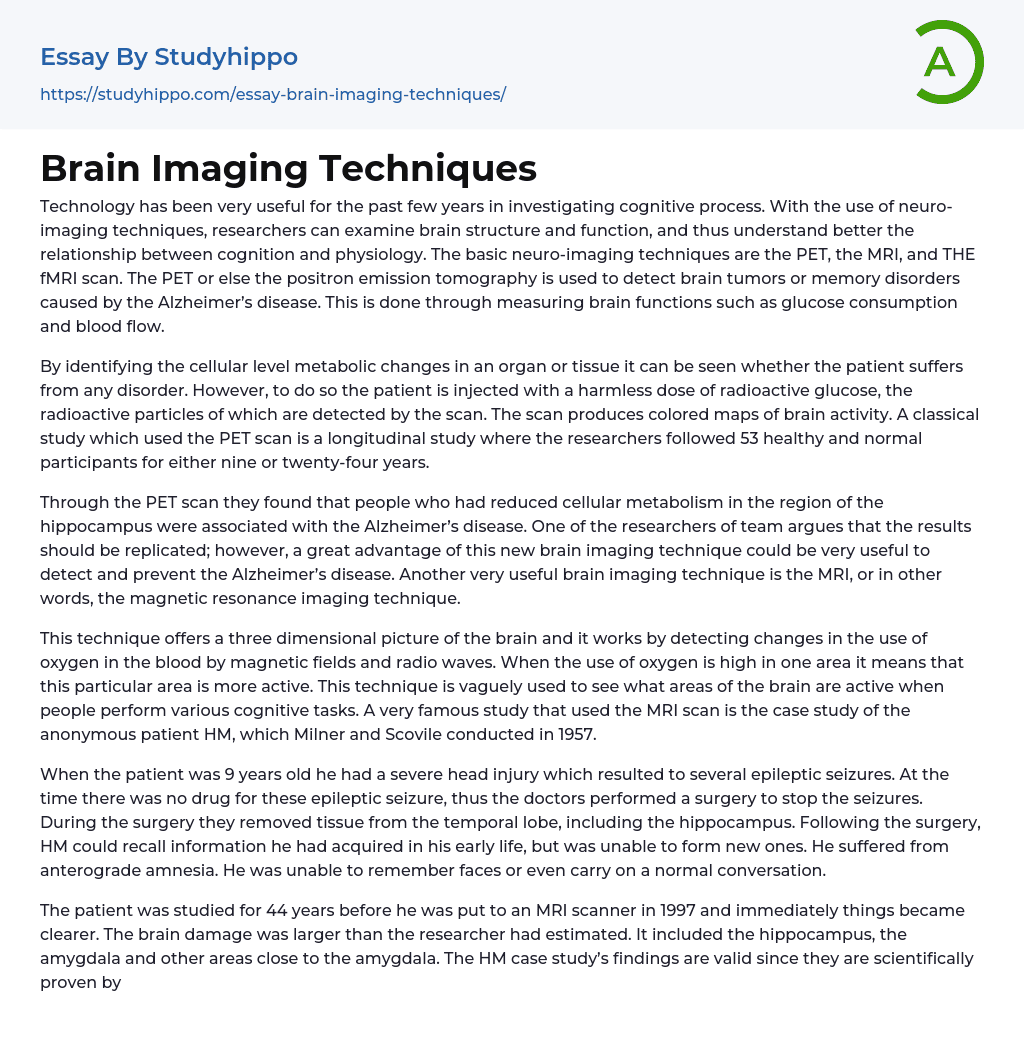Technology has been very useful for the past few years in investigating cognitive process. With the use of neuro-imaging techniques, researchers can examine brain structure and function, and thus understand better the relationship between cognition and physiology. The basic neuro-imaging techniques are the PET, the MRI, and THE fMRI scan. The PET or else the positron emission tomography is used to detect brain tumors or memory disorders caused by the Alzheimer’s disease. This is done through measuring brain functions such as glucose consumption and blood flow.
By identifying the cellular level metabolic changes in an organ or tissue it can be seen whether the patient suffers from any disorder. However, to do so the patient is injected with a harmless dose of radioactive glucose, the radioactive particles of which are detected by the scan. The scan produces
...colored maps of brain activity. A classical study which used the PET scan is a longitudinal study where the researchers followed 53 healthy and normal participants for either nine or twenty-four years.
Through the PET scan they found that people who had reduced cellular metabolism in the region of the hippocampus were associated with the Alzheimer’s disease. One of the researchers of team argues that the results should be replicated; however, a great advantage of this new brain imaging technique could be very useful to detect and prevent the Alzheimer’s disease. Another very useful brain imaging technique is the MRI, or in other words, the magnetic resonance imaging technique.
This technique offers a three dimensional picture of the brain and it works by detecting changes in the use of oxygen in the blood by magnetic fields and radio waves. When th
use of oxygen is high in one area it means that this particular area is more active. This technique is vaguely used to see what areas of the brain are active when people perform various cognitive tasks. A very famous study that used the MRI scan is the case study of the anonymous patient HM, which Milner and Scovile conducted in 1957.
When the patient was 9 years old he had a severe head injury which resulted to several epileptic seizures. At the time there was no drug for these epileptic seizure, thus the doctors performed a surgery to stop the seizures. During the surgery they removed tissue from the temporal lobe, including the hippocampus. Following the surgery, HM could recall information he had acquired in his early life, but was unable to form new ones. He suffered from anterograde amnesia. He was unable to remember faces or even carry on a normal conversation.
The patient was studied for 44 years before he was put to an MRI scanner in 1997 and immediately things became clearer. The brain damage was larger than the researcher had estimated. It included the hippocampus, the amygdala and other areas close to the amygdala. The HM case study’s findings are valid since they are scientifically proven by the MRI scan. However, the study cannot be replicated to other humans to test its validity. Finally, there is the fMRI, or else; the functional magnetic resonance imaging technique.
They way it works and its results are the same with the MRI however, there is a slight difference between the two; the fMRI focuses on the function of the brain. Clinton Kilts was a researcher that
conducted a series of experiments using the fMRI scan. His aim was to investigate the role of the brain in product preferences. A self selected sample of volunteers was asked to rate a number of consumer goods in terms of preference, giving them points according to their level of attractiveness.
Then, the participants were put in an fMRI scan were the same process of rating took place, while the scan measures their brain activity. Results showed that every time a person rated a product highly there was activity in a small area in the medial prefrontal cortex. With reference to a theory which supports that this area is related to our sense of selves and personality, Kilts explained that if we like a product we somehow identify with it. Concluding, we see that the brain imaging techniques offer great help to the psychologists who try to understand better the role of cognition.
However, when evaluating those techniques we see that despite their great advantages they have some disadvantages. Firstly, the scans are not a natural environment for cognition, so there is a question of ecological validity. Secondly, the use of colors may be exaggerated. Also, brain areas might activate for various reasons, thus, one cannot be sure that a certain cognitive activity was related to a change in the brain. Finally, all the above mentioned techniques use radioactivity, which raises a question of ethics in research for the participants as well as of health for the patients.
- Microbiology essays
- Bacteria essays
- Cell essays
- Enzyme essays
- Photosynthesis essays
- Plant essays
- Natural Selection essays
- Protein essays
- Viruses essays
- Cell Membrane essays
- Human essays
- Stem Cell essays
- Breeding essays
- Biotechnology essays
- Cystic Fibrosis essays
- Tree essays
- Seed essays
- Coronavirus essays
- Zika Virus essays
- Central Nervous System essays
- Sleep essays
- Traumatic Brain Injury essays
- Epilepsy essays
- autism essays
- Alzheimer's Disease essays
- Sleep Deprivation essays
- Agriculture essays
- Albert einstein essays
- Animals essays
- Archaeology essays
- Bear essays
- Biology essays
- Birds essays
- Butterfly essays
- Cat essays
- Charles Darwin essays
- Chemistry essays
- Dinosaur essays
- Discovery essays
- Dolphin essays
- Elephant essays
- Eli Whitney essays
- Environmental Science essays
- Evolution essays
- Fish essays
- Genetics essays
- Horse essays
- Human Evolution essays
- Isaac Newton essays
- Journal essays




